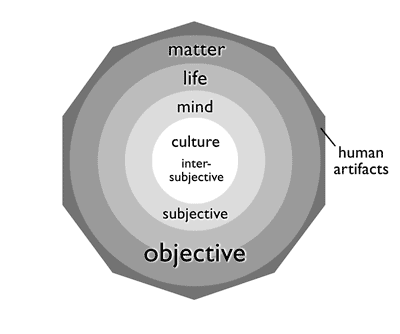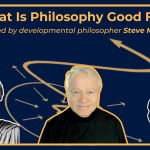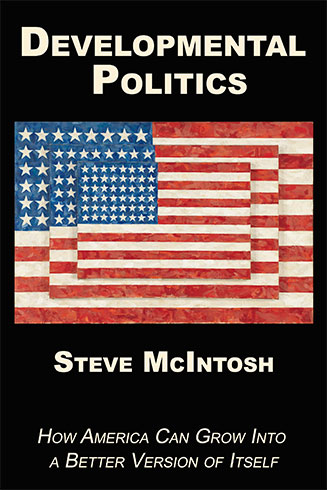Integral Consciousness
Chapter Two The Internal Universe
When we talk about the evolution of stars and planets, or the evolution of life forms, we’re talking about the development of visible material structures. But when we talk about the evolution of culture and consciousness, we are talking about development that is for the most part, invisible. We can certainly see outward manifestations of these developments, such as changes in behavior or bigger buildings. But according to integral philosophy, a big part of that which is actually evolving is internal.
I use the word “internal” to refer to what might be understood as “locations” within subjective consciousness and intersubjective culture (which I’ll explain below). As noted earlier, we all have a direct experience of the inwardness of our own minds. We use phrases like “in my head” and “in my heart.” The experience of an inner life defines what it means to be human. Yet behind the commonplace notion of an external, objective, outside world and an internal, subjective inner experience is an important chapter in the history of ideas.
Today, we take the idea of “objective facts” and “subjective opinions” for granted. But there was a time in history when most people didn’t think in terms of the distinction between objective and subjective. It was the French genius Rene Descartes who really systematized this way of thinking back in the 17th century. Descartes methodically questioned the relationship between mind and world, and in answer to his questions he proposed a radical distinction between the physical body and nonphysical consciousness. According to Descartes, mind and matter were distinct entities composed of entirely different substances—matter was natural, and mind was supernatural. This distinction proved very useful at first. The trend of thinking represented by Descartes provided Europeans with a new “objective” way of seeing the world. With mind and matter separated, the objective world could be examined scientifically, it could be studied from the perspective of an “outside observer.” Perhaps more than any other single person, it was Descartes who triggered the scientific revolution that resulted in what is now called modernism.
The emergence of modernism in the 17th century constituted a new stage or level of consciousness. As we will explore more fully in the pages ahead, “modernist consciousness” brought a new way of seeing things; it offered a new set of values, a worldview that was distinct from the more mythological worldview of medieval Christianity that preceded it.
The modernist worldview epitomized by Descartes allowed people to see the world in a fresh way; it opened up the external universe to new discovery. Through the lens of this new philosophy, early modern intellectuals could, for the first time, see things scientifically. And this new way of seeing things, this new scientific method, eventually resulted in unprecedented material progress. The liberated mind of the modernist produced what historian Richard Tarnas calls “spectacularly tangible results.” So it is important to look back at this chapter in history because it tells us a lot about what is happening now. Just as the emergence of modernism produced cultural evolution through its new understanding and mastery of the external universe, we will soon begin to see how the emergence of the integral worldview will result in similarly dramatic cultural evolution through its new understanding and mastery of the internal universe.
As I explain in detail in chapter 8 on the Integral Reality Frame, today, Descartes’ distinction between mind and matter (now known as “dualism”) has been largely rejected by the materialists who maintain that mind is just an aspect of matter. So as integral philosophy includes and transcends the scientific worldview, it takes notice of the problems of dualism, and thus avoids naively proposing a return to this way of seeing things. According to integral philosophy, the reality we are familiar with does not consist of a natural world and a supernatural world—the external and the internal are both essentially natural. But although the internal and external are recognized as different phases of the same thing, that “thing” is not merely particles of matter.
Like the evolution of consciousness, the evolution of human culture also has an inside and an outside. On the outside of cultural evolution we have what are defined as the external artifacts of civilization—these include the development of words and languages, tools and technology, art and architecture, and organizations such as governments. These human-made artifacts serve as the external manifestations of cultural evolution. But these artifacts of civilization are obviously not living evolutionary systems; they depend on underlying human relationships to give them life. Words, for example, have no meaning unless there is an agreement between at least two people as to what they mean. Similarly in a human organization, if there are no agreements about shared purposes, the organization usually collapses.
When we look at human culture and ask: “what is it that is actually evolving?” we can see that it’s the quality and quantity of connections between people, taking the form of shared meanings and experiences, agreements, relationships, and groups of relationships—these constitute what we might call the organisms of cultural evolution.
This cultural domain of evolution I’m describing is known as theintersubjective—it exists between subjects. And these agreements and relationships that are the structures of cultural evolution have their existence in the internal universe. That is, the substance of a human relationship is the experience that is in our minds and also in the minds of others. Relationships exist in the internal space “in between us,” not wholly in our minds and not wholly in the minds of those with whom we are related, but mutually inside both of our minds, and often simultaneously. These relationship structures are partially independent from our individual subjective consciousness, but at the same time internal and invisible.
When we think about the idea of an internal and external universe, there seems to be a mismatch. The external universe is vast, it stretches to unknown frontiers of space and time. The objective world “out there” seems so much larger and significant than the subjective world “in my head.” And when viewed from this perspective it is no wonder that the scientists who focus on the objective universe often dismiss the nonphysical, internal phenomenon of consciousness as “merely subjective.” In the modernist worldview much greater degrees of reality and significance are attributed to objective entities than to subjective entities. However, when we enlarge our conception of the internal universe to include not only the subjective domain of individual consciousness, but also the intersubjective domain of relationships and human culture as a whole, the internal universe begins to look more substantial. It is important to have some idea of “where” the internal structures of cultural evolution actually exist. These systems of human relationships are not “in the air,” nor are they merely in our minds. They exist in the intersubjective domain of the internal universe.
The idea of the intersubjective domain of evolution can sometimes be difficult to grasp, but one way to see its significance is to ask: what is real? Well, objects are real, consciousness is real, and relationships are real. Indeed, when faced with death, humans fear the loss of their relationships—separation from their loved ones—as that which they dread the most. Relationships have a definite ontological status—their being is as real as anything else. The difference between a real intersubjective relationship and an imagined (and thus merely subjective) relationship is that real relationships impact us in ways we can’t always anticipate or control. Real relationships move us. And the relationships found in the intersubjective domain encompass more than our personal relations with family, friends and colleagues, they also include what we might call “indirect” relationships—relationships with our favorite authors, artists, musicians, and public figures, living and dead. Indirect relationships can be remote in space or time—they do not require direct contact or real-time communication—yet such relationships can be very significant to our consciousness. Meaningful relationships need not be directly personal to move us; we can engage in meaningful relationships with our heroes by simply allowing their words, deeds, or art to communicate with us in the present. As long as there is communication (even one-way communication), there is a relationship.
A recent example of the evolution of culture produced through the development of indirect intersubjective relationships is found in the significant impact made by the music of Bob Dylan in the 1960s. When Dylan sang The Times They Are a Changin’ he “sat behind a million eyes and told them what they saw.” His music caused people to agree with him at a deep level of feeling, and those who together formed Dylan’s audience found themselves to be in a kind of indirect relationship with each other to the extent that they were all deeply moved. The beauty and truth communicated by the music of Dylan and his contemporaries in the sixties produced a solidarity of understanding that helped a new type of culture to be born. We can see the importance of these indirect relationships in the evolution of culture when we realize that all culturally significant works are forms of communication, and that the receipt of this communication always creates an intersubjective relationship between the receiver and the person or group that created it.
When we begin to see the evolving reality of not only the objective external universe and the subjective interior of consciousness, but also the intersubjective realm of relationships, this constitutes a significant new way of seeing things. Just as Descartes’ vision of the objectivity of external reality resulted in the opening of a new frontier of human progress, so too does integral philosophy provide a new way of seeing things by revealing how intersubjectivity (in concert with subjectivity) comprises the internal universe. This idea of intersubjective evolution emerges out of murky abstraction when we begin to see the presence of living systems within the intersubjective realm exhibited in the reality of human relationships. That is, relationships are the real, evolving, living systems of human culture. And, as we will examine below, this vision of relationship systems is fortified by the integral worldview’s recognition and incorporation of the recent discoveries of systems science. As we will see, it is this new understanding of the systems of cultural evolution that endows integral philosophy with the ability to positively impact the condition of human society everywhere.
The diagram shown in Figure 2-1 below illustrates the nested nature of the internal domains of evolution. The concentric circles show how life emerges from inside matter, how consciousness emerges from inside life, and how culture develops, in a way, inside consciousness through the relationships found in the internal domain that exists “in between” the consciousness of individuals. Figure 2-1 also shows human-made artifacts in the objective domain (such as languages, technologies, art, architecture, etc.), because even though artifacts are not natural evolutionary systems, they are significant in the way their development objectifies the intersubjective evolution of culture. This diagram shows all the various types of evolution—the chemical and geological evolution of matter, the biological evolution of life, the personal evolution of consciousness, the collective evolution of culture, and the corresponding development of material artifacts. Figure 2-1 also shows how these different types of evolution fall into three main categories: objective, subjective, and intersubjective. These three great domains of evolution are what Ken Wilber calls “the IT, the I, and the WE”—objective, subjective, and intersubjective, or simply: nature, self, and culture.
 Figure 2-1. The basic types of evolutionary development
Figure 2-1. The basic types of evolutionary developmentshown within the essential domains of evolution
So although we cannot completely avoid metaphysics, we can continually refine our metaphysical understanding through observation and agreement. As we’ll discuss more fully in chapter 8, integral philosophy strives for a minimalist metaphysics, and it is thus careful to avoid becoming just another belief system. Integral philosophy recognizes that while truth is never fully absolute, it is also not completely relative—truth is best understood as an actual direction of evolution in consciousness and culture. So as we strive for a minimalist metaphysics, we hold onto our integral reality frame very loosely, recognizing that it serves merely as the scaffolding for the construction of the next level of civilization.
Nevertheless, we also have to remember why having a conceivable reality frame is important in the first place. History clearly teaches that the emergence of new and more complex worldviews rely on expanded reality frames. As we’ve seen, during the Enlightenment the new agreement about reality facilitated by Descartes’ metaphysics provided the vision that resulted in scientists being able to literally grab hold of the stuff of the external universe, producing the spectacular achievements of modernism. And now, the new metaphysics of integral philosophy promises to produce similarly spectacular advances. As we come to see how culture and consciousness actually evolve, we can likewise grab hold of the “stuff” of the internal universe. With the new understanding provided by the integral worldview we can begin to realistically address the significant global problems that confront our civilization here at the beginning of the 21st century. According to integral philosophy, just about every problem in the world can be identified, at least partially, as a problem of consciousness; and with integral philosophy we can now begin to see how a key part of the solution to every problem in the world is found in the opportunity to raise or evolve consciousness. As we will explore in the pages ahead, the integral worldview provides a clear vision of how the human condition can be dramatically improved everywhere.
In summary, the period of history known as the Enlightenment opened up the external, objective universe to exploration and discovery. Now in our time, as we look forward into future history, we can see the beginnings of a Second Enlightenment, wherein we can anticipate an “opening up” of the internal universe of consciousness and culture to a similar period of exploration and discovery. While this new frontier of human understanding is largely approached through philosophy rather than science, there is a branch of hard science that extends itself (although tentatively) into the internal universe. And this branch of science, known as systems science, is the subject of the next section.
/snip/





